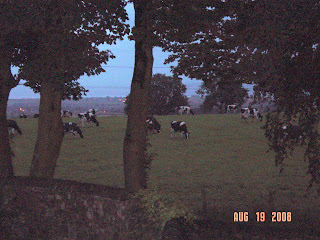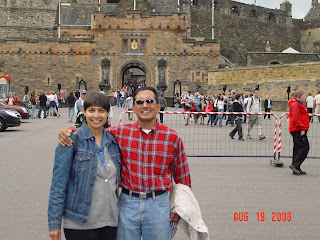Outside Edinburgh Castle
We crossed the border, a little later, entering Scotland and passing through the evocative town of Gretna Green known for the many marriages that took place at the blacksmith’s shop following the many scandalous elopements of the era. By then, darkness had fallen and we were around Lockerbie, site of the infamous Pan Am disaster. We called Kathleen at our B&B for directions. She led us through unmarked country roads which gave us several hairy moments as Llew battled fading light and then pitch darkness, very narrow roads many of which were under construction and driving rain.
 In the midst of those rather stressful conditions, we reached the village of Carnoch and found Carneil Farm B&B (bed and Breakfast–left), a real working farm house attached to barns filled with 200 black and white cows—real beauties—and barns full of hay where we finally met Kathleen who registered us, took our order for a full Scottish breakfast and showed us to our room on the first floor—a very cozy, very charming room beautifully decorated. We fell asleep resolving to get back to our homes wherever these may be early enough and without having to battle such bad driving conditions. Both of us have realized that our eyesight is not what it used to be and we need to work around our limitations.
In the midst of those rather stressful conditions, we reached the village of Carnoch and found Carneil Farm B&B (bed and Breakfast–left), a real working farm house attached to barns filled with 200 black and white cows—real beauties—and barns full of hay where we finally met Kathleen who registered us, took our order for a full Scottish breakfast and showed us to our room on the first floor—a very cozy, very charming room beautifully decorated. We fell asleep resolving to get back to our homes wherever these may be early enough and without having to battle such bad driving conditions. Both of us have realized that our eyesight is not what it used to be and we need to work around our limitations.
Ancient History in Edinburgh:
We showered in a very tiny but very cute bathroom and went down to an enormous breakfast that included Scotland’s most infamous delicacy–haggis (very peppery, very strongly flavored sausage made with minced liver and kidney and stuffed into a sheep’s stomach!) and porridge (very unusual texture and served with honey—lovely!) and Highland oatcakes—tasteless biscuits, like dry toast that we ate with Dundee marmalade. We also ate scrambled eggs and pork sausages, bacon, mushrooms and tomatoes and brown toast with preserves and cheese spread and decaff coffee—on top of pineapple juice! This, as you can imagine, kept me going till 5 in the evening as we went about covering the most important tourist sites in Edinburgh—pronounced ‘Edin-bra’.
Across the Firth of Forth:
I loved the sound of that tongue-twister—The Firth of Forth. Forth is the name of the river and a firth is a small estuary. Hence, we had to cross the estuary of the river to get to Edinburgh from Dunfermline where our B&B was located (because Edinburgh was chocobloc and we simply could not find any accommodation there).
On Kathleen’s advice, we decided to leave our car at a ferry car park near the Forth Bridge and took a public bus to get into Edinburgh which we reached in about a half hour after getting to the ferry park via rural country roads and tiny villages. I slept on the bus, and when I awoke, I was in the capital city of Scotland at St. Andrew’s Square where the bus station was located.
Festival Time in Edinburgh:
 Edinburgh was simply crawling with tourists and culture-vultures as the famous annual summer Edinburgh Festival was on as was the Fringe. We paused for a while at the Scott Monument to listen to a few bagpipers play for the tourists.
Edinburgh was simply crawling with tourists and culture-vultures as the famous annual summer Edinburgh Festival was on as was the Fringe. We paused for a while at the Scott Monument to listen to a few bagpipers play for the tourists.
The Heights of Edinburgh Castle:
A quick stroll through Princes Gardens, full of flowering hydrangeas, took us towards the Castle which is one of the most important tourist sights. There a steady climb took us to the Ticket Booth where for £12 we had a guided tour that included the Honors of Scotland, i.e. the Crown Jewels, the oldest in Europe—a crown, a scepter and a sword lie on a satin coverlet enclosed in a glass case right besides the notorious Stone of Scone which was returned to Scotland in 1996—I had last seen it under the famous throne in Westminster Abbey 22 years ago. We also saw the two memorials to fallen Scottish soldiers from the American War of Independence onwards as well as the magnificent Great Hall, its walls covered with arms and armor, where so many royal banquets were held—rather similar to the many castles we have seen all over Eastern Europe. We also visited St. Margaret’s Chapel, one of the oldest buildings in Edinburgh and the smallest—able to seat only 25 people—and admired its exquisite stained glass windows!
Then, we found ourselves passing through the main courtyard of the Castle where the stands were all set for the famous Military Tattoo (for which, unfortunately, we were unable to obtain tickets as they were sold out months ago) and found ourselves walking along the famous Royal Mile which is lined with souvenir stores, shops selling superb Scottish woolen products and restaurants–not to mention places where you can buy a kilt (as I had done 22 years ago).
We saw some stupendous old churches along the way including the Church of St. Giles. Everywhere, there were performers galore giving street shows and dressed in costume—part of the many festivals going on simultaneously including the famous Fringe.
Scotland’s Colorful History at Holyrood House:
 About twenty minutes later, at the end of the Royal Mile, we arrived at the famous Palace of Holyrood House which is still used as a royal residence by the Queen during her visits to Scotland. I took a picture with Llew on the same bench on which I had posed 22 years ago with Hyun-Sook Jeong from Oxford. Paying £8, we were given audio guides as part of our tickets that allowed us to guide ourselves through the splendid palace which was rather similar in style to the Wren-designed courtyard at Hampton Court Palace. Then, we were walking through the superbly decorated rooms still used by the Queen to host royal banquets today.
About twenty minutes later, at the end of the Royal Mile, we arrived at the famous Palace of Holyrood House which is still used as a royal residence by the Queen during her visits to Scotland. I took a picture with Llew on the same bench on which I had posed 22 years ago with Hyun-Sook Jeong from Oxford. Paying £8, we were given audio guides as part of our tickets that allowed us to guide ourselves through the splendid palace which was rather similar in style to the Wren-designed courtyard at Hampton Court Palace. Then, we were walking through the superbly decorated rooms still used by the Queen to host royal banquets today.
Eventually, we entered the most ancient part of the palace including the area associated with the ill-fated life of Mary Stuart, Queen of Scots. What was most evocative was seeing her own bed chamber and the adjoining tiny dining room where she was at a meal with her ladies when three men broke in and, in her presence, stabbed her Italian secretary Rizzio 59 times. Her own husband, Robert Darnley is said to have been behind this murder being maddened by jealousy and suspecting his wife of having an affair with Rizzio—Darnley himself was killed a year later. We were actually shown the spot at which Rizzio fell as the Queen screamed in terror.
Also very interesting was the Long Portrait Gallery with 89 portraits of all of Scotland’s kings who ruled the country since the time of the Egyptian pharaohs. Then, with the light fading, it was time for us to get back to our B&B by a reverse journey on the public bus—but not after eating a lousy Italian dinner at a restaurant called Montrane where I had the first bad lasagne of my life (and Llew’s prawn sandwich was pathetic).Despite my doubts that we’d find our way back to Carnoch to our Carneil Farm B&B, we did get back rather easily and settled down for the night.
To follow us on the next leg of our travels, please click on the Glasgow link.

